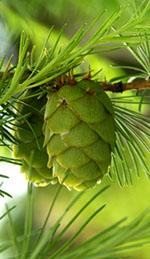 The common silver fir (Abies alba) is a large coniferous evergreen tree native to Europe, and is also called the European Fir or White Fir. Its clear to pale yellow essential oil is obtained by steam-distillation of the needle-shaped leaves and posesses a rich, sweet-balsamic odor reminiscent of the primeval evergreen forests where it originated. Like other balsamic and pine oils, fir needle essential oil is used in aromatherapy to treat upper respiratory infections, congestion, and related respiratory issues [1], and as a circulatory stimulant [2].
The common silver fir (Abies alba) is a large coniferous evergreen tree native to Europe, and is also called the European Fir or White Fir. Its clear to pale yellow essential oil is obtained by steam-distillation of the needle-shaped leaves and posesses a rich, sweet-balsamic odor reminiscent of the primeval evergreen forests where it originated. Like other balsamic and pine oils, fir needle essential oil is used in aromatherapy to treat upper respiratory infections, congestion, and related respiratory issues [1], and as a circulatory stimulant [2].
The silver fir grows between 40 and 50 meters (130 to 165 feet) tall and has glossy dark green leaves and elongated cones. Ranging as far west as the Pyrenees in Spain, east to the Carpathian mountains and down into southern Italy, the fir tree is commonly harvested for its soft wood, which is used to make packing crates, paper, and other wood-based materials. In centuries past, native Americans burned the branches and cones of a related fir species as a ritual incense to center the mind and increase awareness. Silver fir trees also used to be the preferred species for making into Christmas trees, but other species with denser foliage such as the balsam fir and blue spruce have now replaced it [3].
The leaves of Abies alba are the preferred source of fir needle essential oil, which is frequently used in making soaps, perfumes, bath products, and aromatherapy diffusion blends [3]. Extremely popular for its clear, elevating scent, fir needle oil is often diffused into the air to lift the mood, increase energy and act as an antiseptic, especially during the winter months. Fir needle oil is used in targeted aromatherapy treatments as a decongestant and expectorant for respiratory congestion [4], and as a topical rub for sore muscles, sprains, and painful joints [5]. One easy way to use fir needle essential oil to treat congestion is to dilute a few drops of the oil in a salve or lotion and massage it into the chest, back and soles of the feet: the oil’s mucolytic effects will instantly start to relieve congestion as the oil is absorbed through the skin as well as inhaled.
Fir boughs were once burned in saunas to create purifying vapors that cleansed the body of toxins. So while fir needle essential oil acts as a circulatory stimulant and detoxifier on its own [2], one way to increase its therapeutic effects is to add a few drops of the oil to a warm bath. The warm water encourages the oil’s absorption, leaving the whole body feeling toned, energized, and rejuvenated!
REFERENCES
1. Group, Edward F. “The Health Benefits of Pine Oil”. Global Healing Center. Last modified September 10th, 2013. http://www.globalhealingcenter.com/natural-health/pine-oil/.
2. “Fir Needle Essential Oil”. Ayurvedic Oils. Accessed June 18th, 2014. http://ayurvedicoils.com/tag/fir-needle-essential-oil.
3. “Abies alba”. Wikipedia. Last modified June 18th, 2014. http://en.wikipedia.org/wiki/Abies_alba.
4. “Treat Cough With Fir Needle Oil”. Fir Needle Oil. Accessed June 16th, 2014. http://firneedleoil.com/cures-treatments_ahem-ahem-treat-cough-with-fir-needle-oil_37.html.
5. “Fir Needle Essential Oil”. AromaWeb. Accessed June 19th, 2014. http://www.aromaweb.com/essential-oils/fir-needle-oil.asp.
